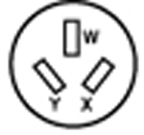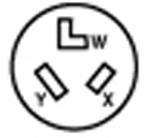
10-50R
These are the receptacles PRIOR to the 1996 NEC change we are talking about. For more information also check out the "Appliance Service" on this site.

10-30R
| Ground Wire on the Old Appliance Outlets |
| If you are contemplating about using your 3-pole 3-wire Appliance service for your RV WITHOUT modification PLEASE read the following article by: Eric Gunnerson |
|
10-50R |
These are the receptacles PRIOR to the 1996 NEC change we are talking about. For more information also check out the "Appliance Service" on this site. |
10-30R |
| Quote:
"All combination 240/120 V circuits require a neutral for the return path. Dryers since they use a neutral or grounded conductor (white wire) for the 120-volt part of the circuit are no exception. In addition circuits are now required to also contain a safety-grounding conductor (green, bare, or using the metal sheath or conduit) as the fourth wire. This has been the situation for many years. However, during WW2 due to measure to conserve copper wire, the NEC made an exception for dryers and stoves which allowed the grounding conductor (bare, green or conduit) to carry the return current back for the 120 volt leg. This is not a very good safety feature (for example the Canadian Electrical Code never allowed this exception for many good reasons). After the war, in every subsequent NEC code making panel proposed to rescind this exception, but every time, the electrical manufacturer's coalition opposed the change in the general voting for approval, the logic being that the additional conductor would make the installation less attractive (read more expensive) than gas appliances. Finally (after many electrocutions) in 1996 this exception made for dryers and stoves was indeed rescinded mandating four prong receptacles and plugs i.e., one for each hot leg, one for the neutral, and one for the ground wire/green was rescinded. So what does this mean in construction? New house wiring for dryers and stoves MUST (according to the NEC) be four wires and four prongs, i.e., 2 hot's, 1 neutral, and a ground. It is the responsibility of the manufacturer to provide new dryers and stoves with 4 prong plugs (if any) or have the electrician install the pigtail. There are obviously two big problems. 1) If you are moving into a new home with a four prong dryer or stove outlet and you are bringing your old dryer or stove with you, you must rewire the old appliance with a new four wire/four prong cord and plug (and disconnect the bonding jumper between the neutral and ground at the appliance). 2) If you buy a new dryer or stove with a four-prong cord/plug on it and your house has the old 3-prong receptacle you have many options: A) The safest is to install a 4-prong receptacle. If you are lucky there might already be a separate neutral and ground there so all the electrician has to do is change the receptacle to 4 prongs. If not, then a new circuit "should" be run (in order to take advantage of this safety feature). B) However the NEC is not retroactive and thus allows replacement in kind i.e., you are allowed if you chose to change the cord and receptacle to three wire/3 prong (and you must also install the bonding jumper between the neutral and the ground wire inside the appliance). In this latter situation (C) You are simply replacing the old unsafe system in kind, i.e.., with a new but just as unsafe as the old one. In other words there is going to be some "incompatibility with this new code for quite some time. The safety issue with the old 3-prong system is, that if the neutral wire gets loose at the receptacle or at the panel board, then the chassis of the appliance is looking for a return path to ground (i.e., it becomes hot). If you or the customer touches the metal frame and is on concrete, on the earth, or in contact with a sink or cold water pipe, their body unfortunately presents an electrical path to ground. This would not be the case in the 4-wire system with the neutral totally disengaged from the chassis." From: Eric Gunnerson |